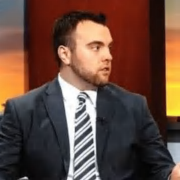Revealing the 50 Most Influential Teams in NFL History: Nos. 20–11

The National Football League has played 104 seasons, dating back to its roots as the American Professional Football Association (APFA) in 1920.
Since then, there have been 2,321 teams spanning the NFL’s and American Football League’s history. Yet only a select few have made a lasting difference, something by which they have been—and will forever be—defined.
- Read the full list here: Counting Down the 50 Teams
During the offseason we brought together a 31-person blue-ribbon panel consisting of media members, analysts, former front office personnel and more, having each vote on more than 100 candidates. Each panelist voted for 50 teams, with their top team earning 50 points and their 50th team garnering a single point.
From those tallies, we detailed why each team deserves to be on the list, including quotes from panelists for every squad. Most importantly, SI reached out to a star player or head coach for every team from the Super Bowl era (1966 to present), gaining valuable insight into what made those teams so unique.
Below are the panelists and their titles, followed by our list. Next up: Nos. 20 to 11. Enjoy.
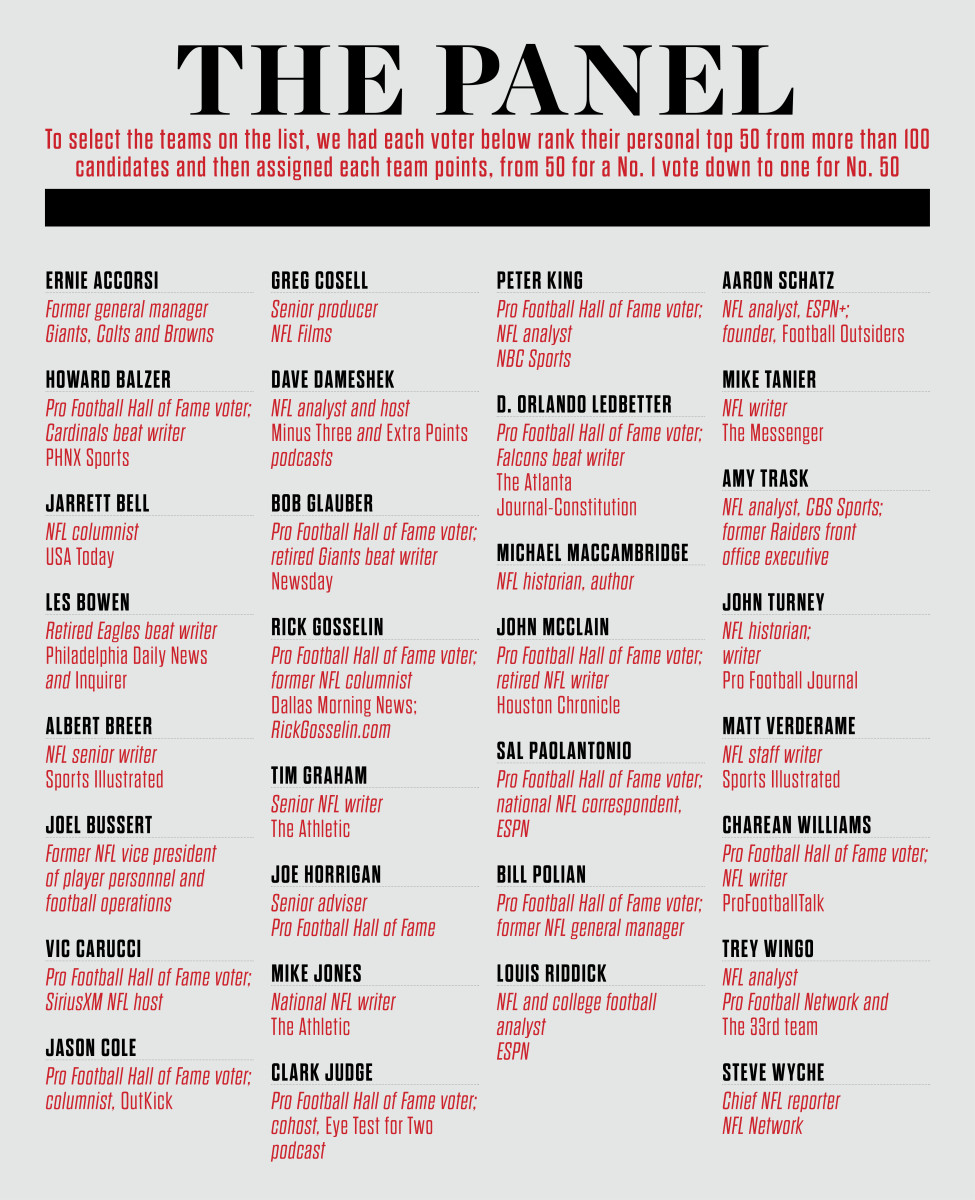
20. 2000 Baltimore Ravens
Record: 12–4, Super Bowl XXXV champions
Coach: Brian Billick
Hall of Famers: Ray Lewis (LB), Rod Woodson (S), Shannon Sharpe (TE), Jonathan Ogden (OT)
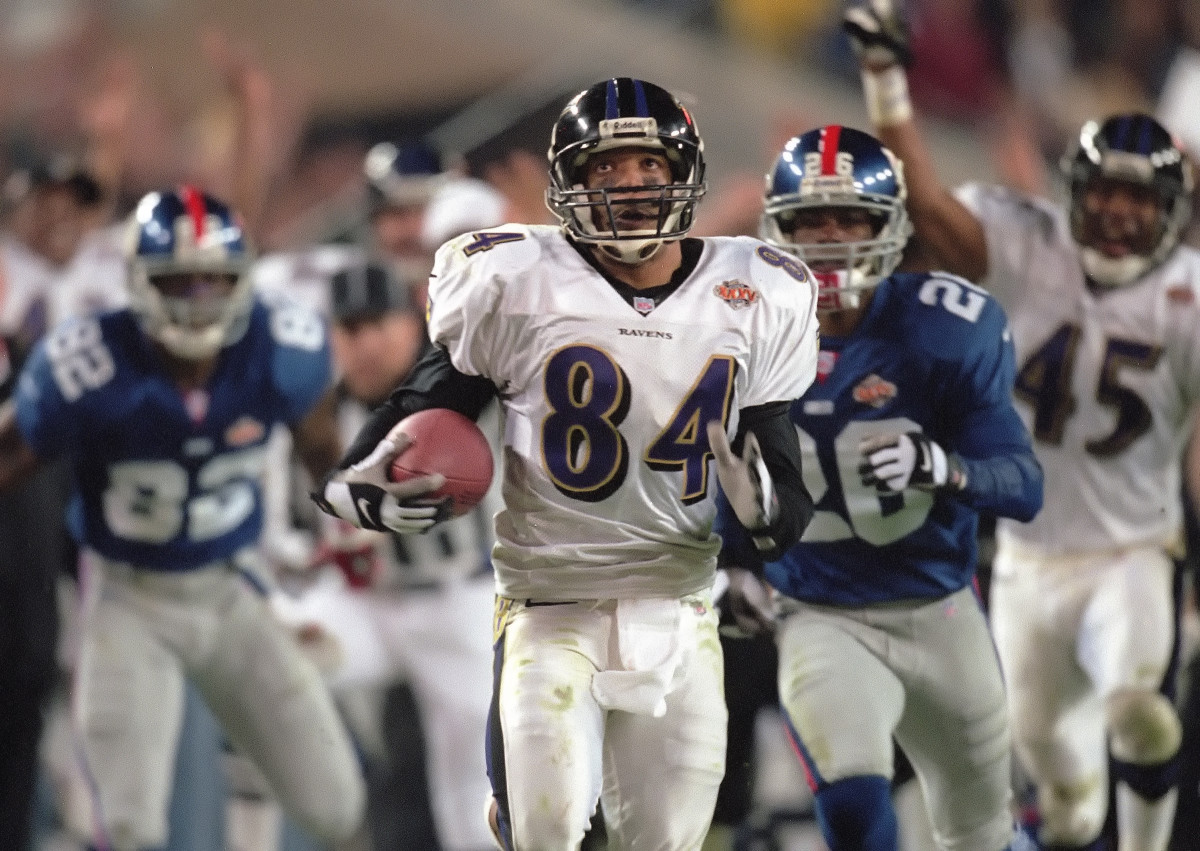
Why they mattered:
The 2000 Ravens went a month without scoring a touchdown. They changed starting quarterbacks at midseason, and let both go after the season ended. And, yet, they won the Super Bowl in dominating fashion.
Perhaps no defense—and certainly none since the new century—has been more overpowering than Baltimore that year. The Ravens notched four shutouts and held opponents to a league-best 10.3 points per game, the lowest total since the 1977 “Grits Blitz” Falcons. In the postseason, Baltimore surrendered 23 total points, including a return touchdown.
The 2000 Ravens were a team built on interior size up front and pursuit at the second level. Baltimore had a pair of monsters in the middle with 330-pound Tony Siragusa and 350-pound Sam Adams, while Super Bowl MVP and first-ballot Hall of Fame linebacker Ray Lewis roamed behind them.
Offensively, Baltimore showed it’s possible to win without a star quarterback. The previous seven Super Bowls had all been won by future Hall of Fame signal-callers, including Troy Aikman, Steve Young, Brett Favre, John Elway and Kurt Warner. The Ravens did it with defense and the ground game, a formula used by the Patriots and Buccaneers over the coming years.
Panel quote:
“Only seven teams have traveled down the wild-card road to the Super Bowl title, and none was more unlikely than the 2000 Baltimore Ravens. The Ravens were 5–3 when a decision was made to bench quarterback Tony Banks and turned the ball over to Trent Dilfer. The Ravens lost another game before they went on a seven-game winning streak to wrap up a wild-card berth. The Ravens featured four future Pro Football Hall of Famers in left tackle Jonathan Ogden, tight end Shannon Sharpe, linebacker Ray Lewis and safety Rod Woodson. They leaned heavily on the defense and a strong rushing attack powered by rookie running back Jamal Lewis and Priest Holmes.” —D. Orlando Ledbetter, Falcons beat writer, The Atlanta Journal-Constitution
Team quote:
“We were so dominating on defense. It had been a long time, maybe since the ’70s Steelers, since you saw a team that was based so heavily on defense and was so dominating. And it was dominating in a record fashion. That captured the personality and the interest of the fans. [The NFL] had good defensive teams, don’t get me wrong, but in the era of it’s all about the offenses and all about the quarterbacks, it was starkly different than the teams that had won prior to it, and quite frankly, the teams that have won since.” —Brian Billick, Ravens coach, 1999–2007
19. 1925 Chicago Bears
Record: 9-5-3, missed playoffs
Coach: George Halas
Hall of Famers: George Halas (HC), Red Grange (RB), Ed Healey (OT), George Trafton (C)
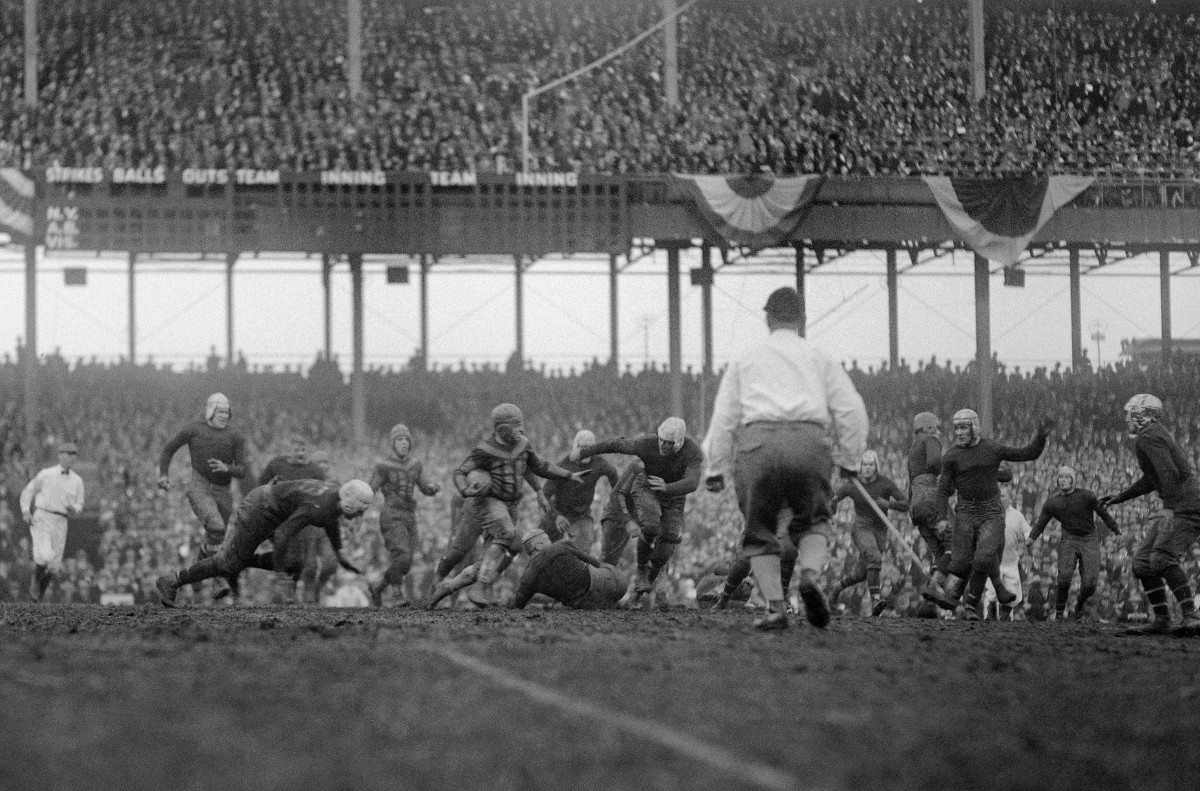
Why they mattered:
The 1925 Bears weren’t one of coach-owner George Halas’s best teams, but they were perhaps the most impactful he oversaw.
With the NFL in only its sixth year (and fourth under that name), the league was still trying to gain notoriety and standing with the U.S. public. While those battles would rage on for the next quarter century, the league’s first big step was Halas signing Red Grange after he finished playing at the University of Illinois.
Grange was a U.S. icon as a collegiate star and immediately gave the NFL gravitas. While the man known as the “Galloping Ghost” played in only 96 career games, scoring 31 touchdowns, the notion that a college star would go professional became much more accepted.
The Bears finished seventh in the NFL standings that year, with the title being disputed between the cross-town Cardinals and long-defunct Pottsville Maroons (the league recognizes the Cardinals as official champions), but that’s secondary to what Grange’s addition to the league meant.
After the season, Grange and the Bears went on a barnstorming tour (see No. 37 on our list) to help continue growing the game across the U.S. It was one of the more impactful stretches the league has known.
Panel quote:
“It wasn’t the Bears’ 9-5-1 record in 1925 that made them noteworthy. After all, it was good for only seventh place in a league won by the 11-2-1 Chicago Cardinals. No, it was the addition of Red Grange and a barnstorming tour that encompassed 19 games in 67 days. Grange joined the team after finishing his collegiate football season at the University of Illinois and, along with his pro teammates, played an astounding eight games in 12 days. Included was a 19–7 defeat of the New York Giants that attracted 73,000 to the Polo Grounds and saved Big Blue from financial ruin.” —Clark Judge, Pro Football Hall of Fame voter
18. 2007 New England Patriots
Record: 16–0, AFC champions
Coach: Bill Belichick
Hall of Famers: Randy Moss (WR), Junior Seau (LB), Richard Seymour (DE)
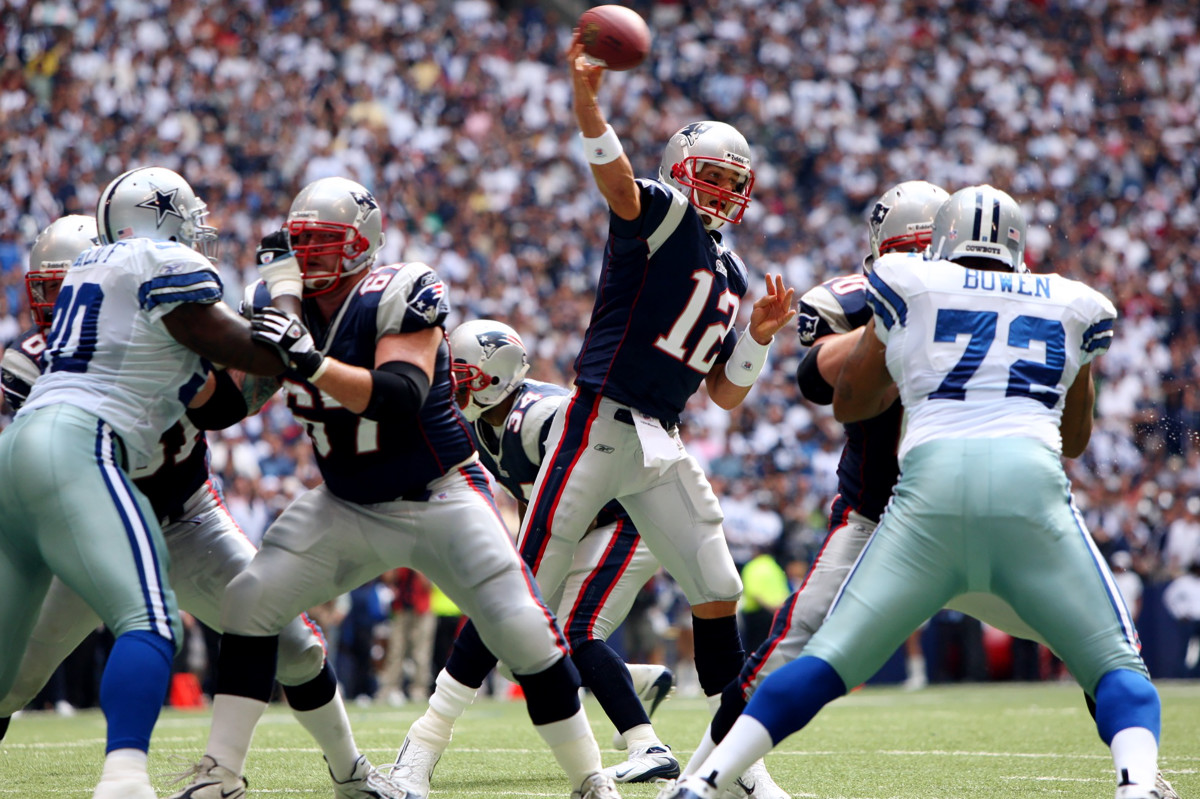
Why they mattered:
If the 2007 Patriots had won their last game, they would be near the top of this list. But in the NFL, one game can change everything.
For New England, that season turned perhaps its greatest player ever from caretaker to superstar. Entering the 2007 season, Tom Brady had never thrown for more than 28 touchdowns or 4,110 passing yards. But in ’07, Brady was given Randy Moss on the perimeter and Wes Welker in the slot. The result was 50 touchdown passes and 4,806 passing yards, leading the Patriots to an undefeated regular-season mark.
While the Colts were throwing the ball with success behind the trio of quarterback Peyton Manning and receivers Marvin Harrison and Reggie Wayne, the league was more of an earthbound game at the time. With Brady and the Patriots opening up, a shift was afoot, with the emphasis suddenly on throwing the ball more as the rules tilted in that direction.
Despite losing Super Bowl XLII to the Giants in stunning fashion, New England reenergized the deep ball while becoming the only team to go undefeated in a 16-game season.
Panel quote:
“The Patriots won each of their first eight games by 17 or more. They scored at least 30 points a dozen times. They scored in the 40s four times. They got to the 50s twice. Tom Brady broke the record for touchdown passes (50), Randy Moss broke the record for touchdown catches (23), and the Patriots broke the NFL scoring record by 33 points. They foretold where offense was going, in the shotgun around half the time when that was unheard of, and with three and four receivers regularly. They did it with Moss, Wes Welker, Donté Stallworth, Logan Mankins, Matt Light, et al. The defense was stocked with vets Richard Seymour, Vince Wilfork, Tedy Bruschi, Mike Vrabel, Junior Seau, Rodney Harrison and Asante Samuel. Yet, in the end, the toll of Spygate and perfection weighed on them, and it all crashed under a dominant Giant defensive front and a helmet catch in the Super Bowl. Otherwise? This team might be the best ever.” —Albert Breer, senior NFL reporter, Sports Illustrated
Team quote:
“It was a super-talented team, but it also had a lot of toughness and grit to it as well. I just think it may have been more talented than some of the other teams that we had, that won a Super Bowl, but I think just in terms of the talent level and the ability to focus week in and week out, I thought that team had a lot of toughness as well. A great combination of both.” —Richard Seymour, Patriots defensive end, 2001–08
17. 1966 Green Bay Packers
Record: 12–2, NFL champions
Coach: Vince Lombardi
Hall of Famers: Vince Lombardi (HC), Bart Starr (QB), Jerry Kramer (G), Forrest Gregg (OT), Willie Wood (S), Herb Adderley (CB), Willie Davis (DE), Paul Hornung (RB), Henry Jordan (DT), Ray Nitschke (LB), Jim Taylor (FB), Dave Robinson (LB)
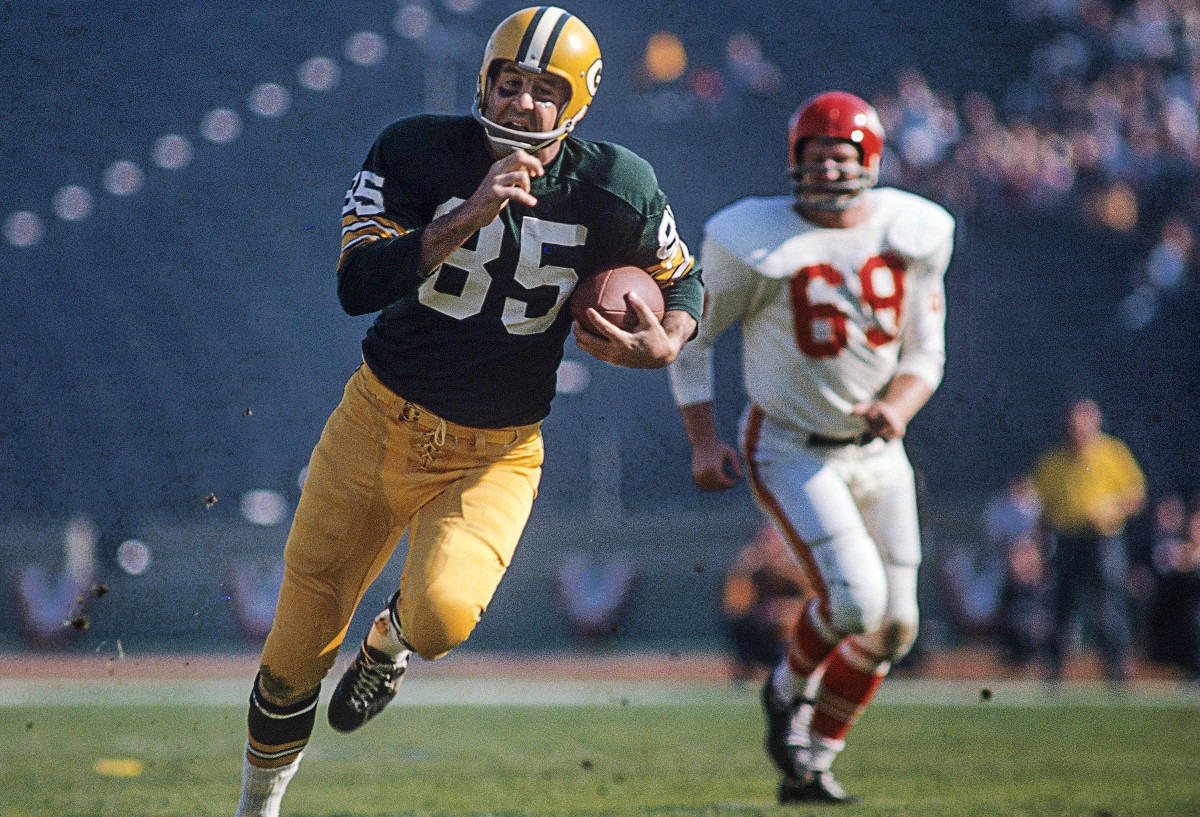
Why they mattered:
It’s a tough task to narrow down the 1960s Packers teams, but the ’66 group checks in as the first of three on our list.
While the 1962 squad is likely the best assembled under Vince Lombardi, the importance of the ’66 team can’t be understated. The NFL’s history tends to be split before and after the invention of the Super Bowl, adding extra gravitas to this year.
After going 12–2 in the regular season, the Packers defeated the Cowboys in the Cotton Bowl to advance and face the AFL champion Chiefs in Super Bowl I. After a tight first half, Green Bay reeled off 21 unanswered points for a convincing 35–10 victory, giving the Packers their fourth championship in six years.
That year, Green Bay outscored its opponents 335–163, ranking first defensively and fourth in scoring. While that era in Green Bay isn’t renowned for creative schemes, the Packers’ style of running and defense was replicated due to their unyielding success.
In 1966, Lombardi’s charges permitted seven touchdown passes while recording 28 interceptions during the regular season, while the offense was led by Bart Starr, who earned MVP honors.
Panel quote:
“They beat the Dallas Cowboys for the NFL championship, then won Super Bowl I as an afterthought. They defined professional football for their era and the next, leaving a permanent mark on how teams are constructed and coached. The Packers were a great team before 1966, but Super Bowl I marks the dawn of modern football history, making Lombardi the sport’s founding father. For folks old enough to remember life before Bill Belichick and Tom Brady, Lombardi was the quintessential coach, his Packers the quintessential team, Lambeau field The Promised Land on a icy afternoon, and the Packers of the ’60s, from their play style to their success to their very aesthetic, the distillation of what every fan is looking for when we sit down to watch a game.” —Mike Tanier, senior NFL writer, The Messenger
Team quote:
“The key to our success, as far as I’m concerned, is Vince Lombardi. Not just the fact [that] he was a great coach; he was the greatest coach. … He chose people not just because they were good, but they were good for his system and his system only. I knew some great ballplayers who left Green Bay because they couldn’t fit in the Green Bay system. No matter how good you were, if you weren’t a Green Bay Packer–type person, he wouldn’t have you.” —Dave Robinson, Packers linebacker, 1963–72
16. 1978 Pittsburgh Steelers
Record: 14–2, Super Bowl XIII champions
Coach: Chuck Noll
Hall of Famers: Chuck Noll (HC), Terry Bradshaw (QB), Franco Harris (RB), Lynn Swann (WR), John Stallworth (WR), Mike Webster (C), Jack Lambert (LB), Jack Ham (LB), Mel Blount (CB), Joe Greene (DT), Donnie Shell (S)
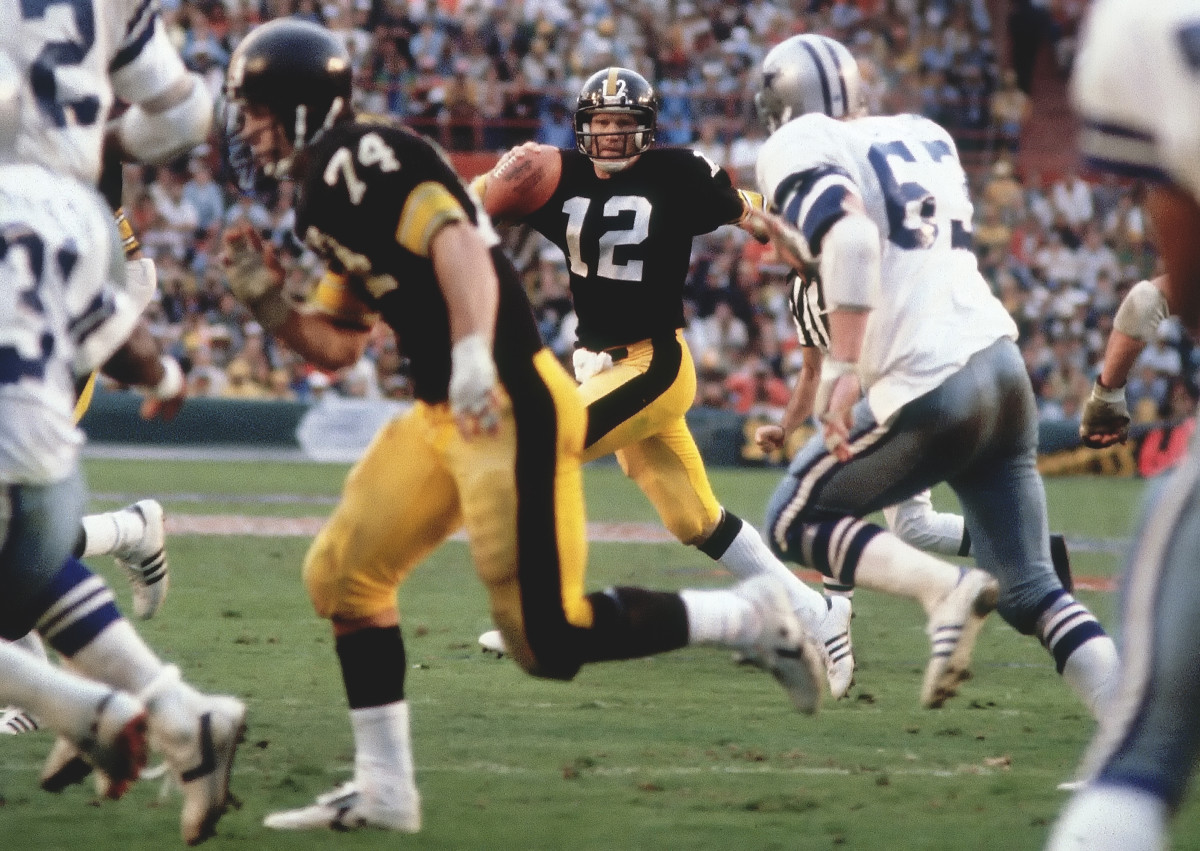
Why they mattered:
After years of dominance, including two Super Bowls and six consecutive playoff appearances, the Steelers were facing a new challenge.
After the 1977 season, the NFL instituted a slew of rules changes after scoring had dipped to 17.2 points per game, the lowest total since World War II. It was largely thought Pittsburgh would suffer from the changes, specifically after seeing Steelers Hall of Fame corner Mel Blount inspired a change that meant receivers couldn’t be interfered with more than five yards downfield.
Instead of struggling, the Steelers surged. They went 14–2 in the NFL’s first 16-game season, with quarterback Terry Bradshaw winning MVP honors after throwing for a league-best 28 touchdowns. Pittsburgh’s defense remained elite, ranking first in points allowed (12.2 points per game), while the offense went from complementary to a costarring role.
After pummeling the Broncos and Oilers by an aggregate score of 67–15 in the AFC playoffs, Pittsburgh hung 35 points on the Cowboys’ Doomsday Defense in a Super Bowl XIII victory.
There’s a strong argument to be made that Pittsburgh’s dynasty in the 1970s is the best in NFL history, and none of those editions was more dominant than in ’78.
Panel quote:
“Pittsburgh’s defense changed the rules and opened up the passing game while winning its third Super Bowl in five years. In a neat bit of irony, the team whose star cornerback so physically dominant the league’s framers felt compelled to create the Mel Blount rule—intended to liberate receivers and boost scoring—ended up adjusting their approach better than any other team in the league. Whereas former 1970s AFC heavyweights such as the Dolphins were outmoded, the Steelers successfully completed a hard right turn away from ground-and-pound to the right arm of Bradshaw, who went from occasional goat to GOAT, winning the ’78 MVP and Super Bowl XIII MVP in his progressive new form.” —Dave Dameshek, NFL analyst and host, Minus Three
Team quote:
“There’s no question about it. When they changed that rule, our offense went crazy. We had a big-time running back in Franco [Harris], big-time receivers and a big arm in [Terry] Bradshaw. The evidence speaks for itself. They ran through the league like a knife through hot butter. It really did change the way the game was played.” —Mel Blount, Steelers corner, 1970–83
15. 1940 Chicago Bears
Record: 8–3, NFL champions
Coach: George Halas
Hall of Famers: George Halas (HC), Dan Fortmann (OL/DL), Bulldog Turner (C/LB), George McAfee (CB/RB), Joe Stydahar (OL/DL), Sid Luckman (QB)
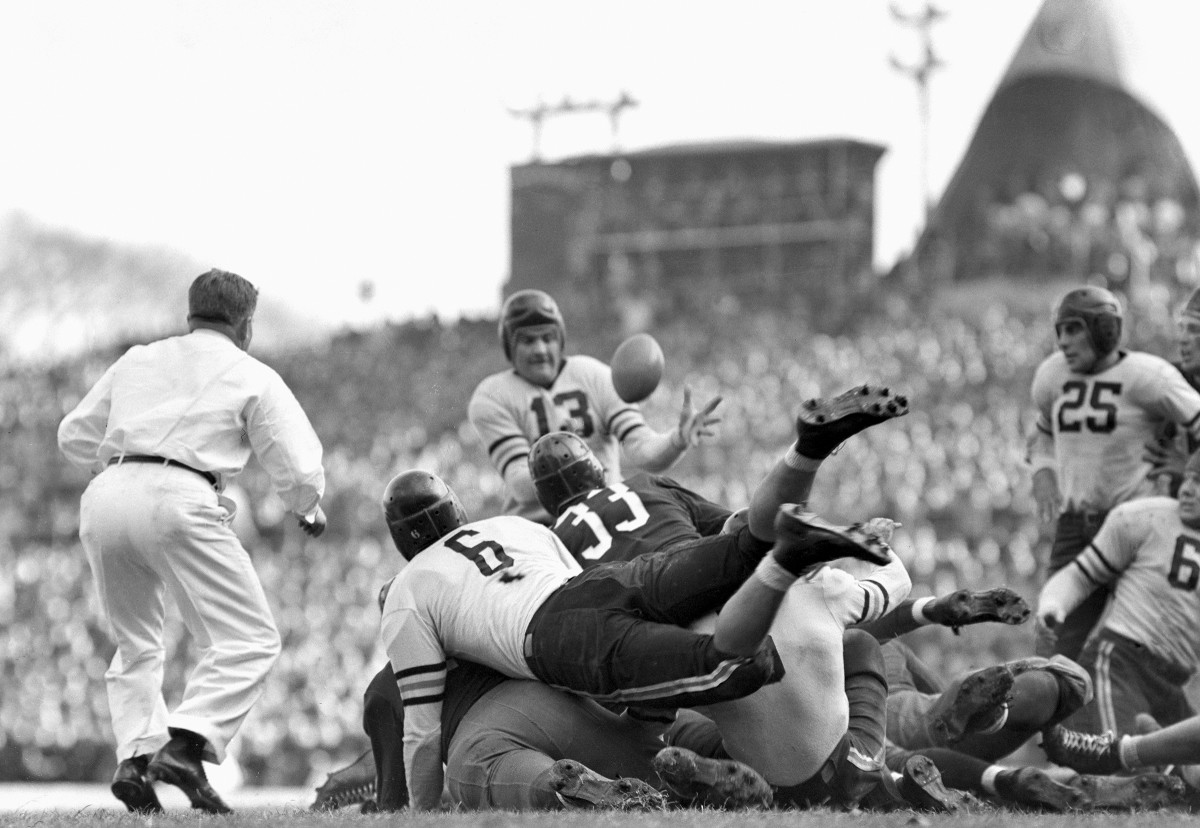
Why they mattered:
Throughout the process of creating this list, myriad Bears teams of the 1920s, ’30s and ’40s were discussed. Yet none were more impactful in the eyes of our panel than the ’40 edition, which faced Washington in the league championship game.
Chicago modernized the T formation—three backs standing in a line five yards behind the quarterback—and used it to destroy Washington by a 73–0 score, still the largest margin of victory in any league game.
While it was Clark Shaughnessy who revitalized the scheme, it was the Bears and Halas who utilized it at the highest level. Shaughnessy’s idea was to take advantage of putting a man in motion, something seldom seen before. In the 1940 title game, Chicago amassed 519 total yards, including a staggering 381 rushing yards and seven rushing touchdowns.
Eventually, the T Formation became a staple across the NFL while Shaughnessy, who coached college football between 1914 and ’46, took the head coaching post with the Rams between ’48 and ’49, totaling a 14-7-3 record while leading Los Angeles to the Western Conference title in his final season.
Panel quote:
“Few teams have had as much impact on the game of football as the 1940 Bears. At that time, only three teams in the football universe were playing the T formation: the Bears, the Stanford Indians and Lake Forest [Illinois] College. But when the Bears defeated Washington in the NFL championship game 73–0, followed a few weeks later by a Stanford victory in the Rose Bowl, it started a revolution that eventually drove the single wing and similar formations into extinction. The Bears won a second consecutive championship in ’41 and another in ’43, and are remembered as the Monsters of the Midway.” —Joel Bussert, former NFL vice president of player personnel and football operations
14. 1969 Kansas City Chiefs
Record: 11–3, Super Bowl IV champions
Coach: Hank Stram
Hall of Famers: Hank Stram (HC), Len Dawson (QB), Emmitt Thomas (CB), Johnny Robinson (S), Buck Buchanan (DT), Curley Culp (DT), Willie Lanier (LB), Bobby Bell (LB)
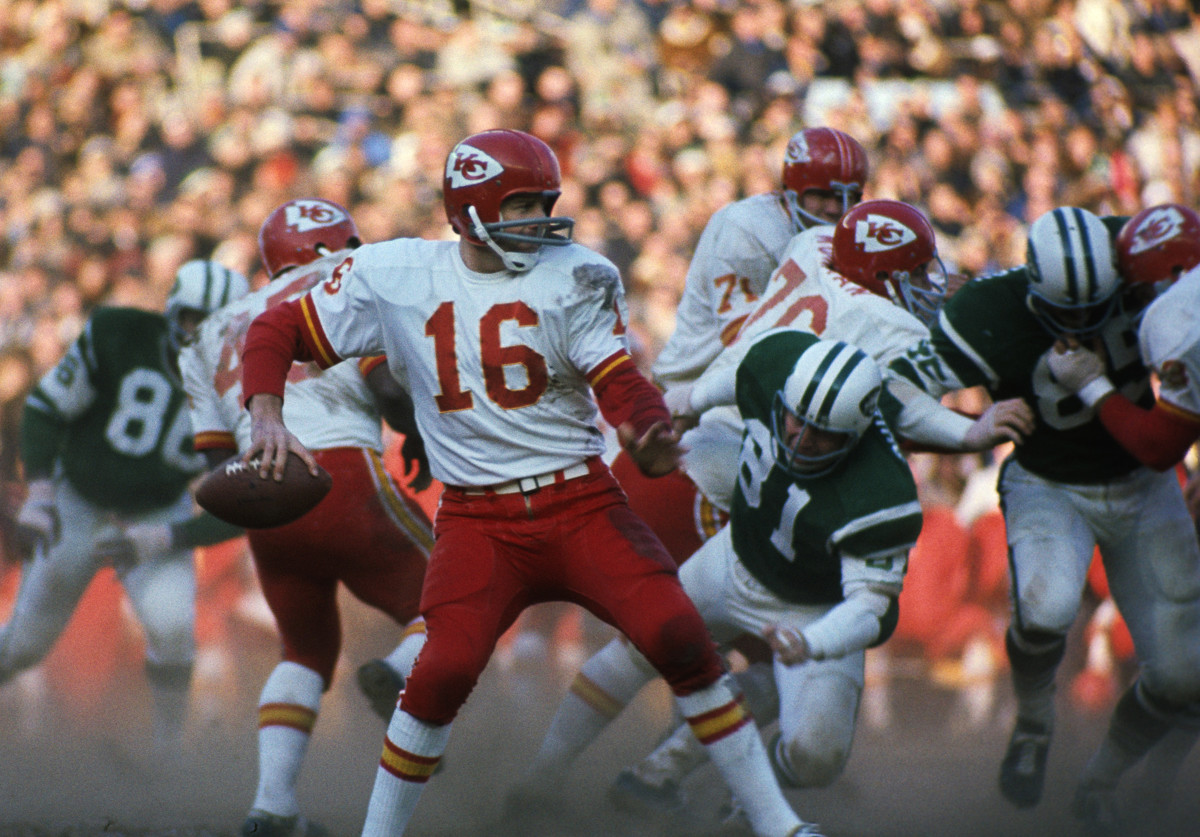
Why they mattered:
The 1969 Chiefs weren’t only a Super Bowl champion; they were confirmation of the American Football League’s validity.
After watching the AFL’s Jets stun the NFL’s Colts in Super Bowl III, Kansas City crushed the heavily favored Vikings in Super Bowl IV, the last game before the AFL-NFL merger took hold.
Kansas City was largely built through drafting players from historically black colleges and universities, including star receiver Otis Taylor (Prairie View A&M), cornerback Jim Marsalis (Tennessee State), Willie Lanier (Morgan State) and Buck Buchanan (Grambling), among others.
This charge was led by scout Lloyd Wells, who routinely earns mention of Hall of Fame induction. In 1969, the defense had eight Black starters, including five Pro Bowlers that season.
Defensively, the Chiefs also played a stack defense, a new style that helped keep the linebackers clean of blockers. The unit is also one of the most decorated in pro football history, with two Hall of Famers at each level.
Offensively, Hank Stram made Kansas City a breeding ground for unique and intricate man-in-motion strategies, something which bedeviled Minnesota in the Super Bowl.
Panel quote:
“They called the ’69 Chiefs ‘Hank Stram’s Wild West Variety Show,’ and it was certainly a trail-blazing squad—the first team in pro football history in which a majority of starters were African American. The Chiefs’ offense was full of innovation (like the Tight I and the moving pocket), but was a title that belonged to the defense. In the postseason, the Chiefs beat the defending world champion Jets 13–6 at Shea Stadium, then proceeded to hold the two highest-scoring teams in football—Oakland and Minnesota—to seven points each, in winning the AFL title and the Super Bowl. It’s no accident that six Hall of Famers played on that defense.” —Michael MacCambridge, NFL historian, best-selling author
Team quote:
“We had a lot of great football players. We have six Hall of Famers from that team on the defense alone. During that year, we played as a team. Len Dawson didn’t play seven games out of that year. Defensively, we told them just kick a field goal and we’ll beat everybody. We didn’t think anybody could score on us. We had some great football players, God almighty.” —Bobby Bell, Chiefs linebacker, 1963–74
13. 1987 Washington
Record: 11–4, Super Bowl XXII champions
Coach: Joe Gibbs
Hall of Famers: Joe Gibbs (HC), Russ Grimm (G), Darrell Green (CB), Art Monk (WR)
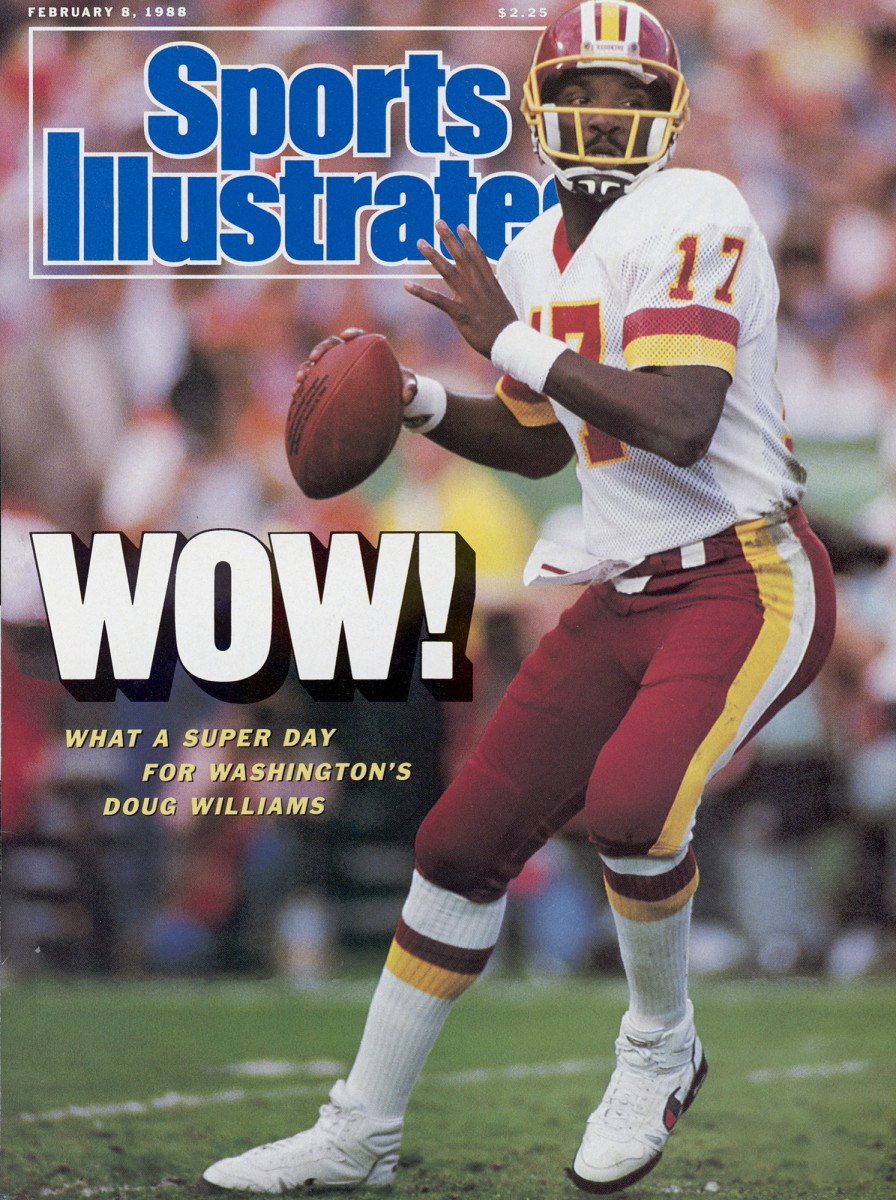
Why they mattered:
In 1987, Washington was the place of progress in the NFL, and the year of Doug Williams and the Black quarterback.
Despite entering the year with Jay Schroeder as his signal-caller, Gibbs eventually elected to sit Schroeder in favor of Williams, who in 1978 became the first Black quarterback to be drafted in the first round. After five years with the Buccaneers, Williams left the NFL before landing in the newly minted United States Football League before rejoining the NFL with Washington in ’86.
For Williams, Gibbs’s belief was a lifeline. Having spent Williams’s rookie year as the offensive coordinator in Tampa Bay, Gibbs saw his talent and, in 1987, turned to Williams for the postseason despite his having started only two regular-season games. In the playoffs, he led third-seeded Washington to Super Bowl XXII with wins over the Bears and Vikings.
On Super Sunday, Williams made history in myriad ways. He became the first Black quarterback to start and win a Super Bowl, while also earning MVP honors after throwing four touchdowns in the second quarter.
Since that day, other Black quarterbacks have been afforded opportunities and flourished, including fellow Super Bowl champions Russell Wilson and Patrick Mahomes.
Panel quote:
“Doug Williams took over late in the season and led Washington through the playoffs to the greatest Super Bowl comeback of its era. A bunch of replacement players went 3–0, beating a Cowboys team full of stars who crossed the picket line at the end of a midseason strike, to make Williams’s postseason heroics possible. [Washington] challenged the era’s perceptions about quarterbacks of color and the relationship between players and ownership. Throw in a three-wide receiver offense and a roster heavy on late-round, small-program draft selections, and they presaged the 21st century NFL in a way few other teams of their era could.” —Mike Tanier, senior NFL writer, The Messenger
Team quote:
“When you talk about team, and together, the 1987 team speaks to that. During the strike, nobody crossed the line; that’s how close that team was. Dallas had guys cross the line, the Giants had people cross the line, everybody did except for [Washington] that year. We had something special through the old cliché of do your job. If one man had crossed the picket line, he wasn’t doing his job because he was by himself. Once we came in as a team, we knew what we had been through and what we had to do.” —Doug Williams, Washington quarterback, 1986–89
12. 1967 Green Bay Packers
Record: 9-4-1, Super Bowl I champions
Coach: Vince Lombardi
Hall of Famers: Vince Lombardi (HC), Bart Starr (QB), Jerry Kramer (G), Forrest Gregg (OT), Willie Wood (S), Herb Adderley (CB), Willie Davis (DE), Henry Jordan (DT), Ray Nitschke (LB), Dave Robinson (LB)
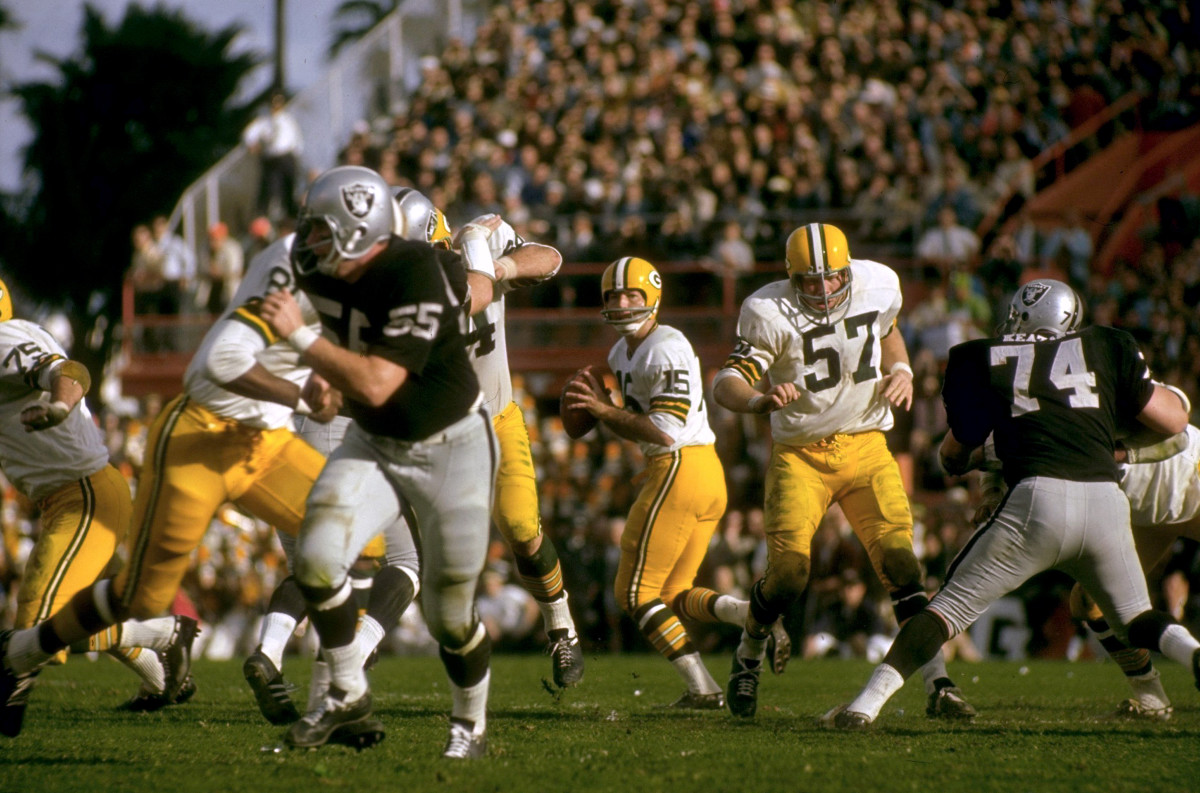
Why they mattered:
The 1967 Packers were the weakest of Vince Lombardi’s championship teams. Yet their historical impact can’t be overstated.
After winning titles in 1965 and ’66, Green Bay was looking to become the first three-peat NFL champion since the league’s creation days when the Packers won championships in ’29, ’30 and ’31. Despite age rapidly becoming an issue, along with the losses of Hall of Fame backs Paul Hornung (retirement) and Jim Taylor (expansion draft), the Packers won the Western Conference.
In the NFL title game on New Year’s Eve, Green Bay hosted the Cowboys in the infamous Ice Bowl with a temperature of -13°. Trailing 17–14 in the final two minutes, the Packers marched 68 yards, with Starr plunging over the goal line as 16 seconds showed on the clock. Two weeks later, Green Bay demolished the AFL champion Raiders, giving it a third consecutive title and fifth in seven years.
For Lombardi and his Packers, the second consecutive Super Bowl win greatly helped cement those teams as what they were—perhaps the greatest group in NFL history both before and after the Super Bowl’s advent.
Panel quote:
“There were better Packers teams in the 1960s, but the ’67 team is the high point of Green Bay’s incredible run under [Vince] Lombardi. The Packers became the first and so far only team to win three consecutive titles since the NFL started using playoffs rather than voting to decide the champion. It was also Green Bay’s fifth title in seven years and last under Lombardi. The Packers went 9-4-1 in the regular season. Three losses were by a field goal, and they were never in jeopardy of not making the playoffs. The NFL championship game against Dallas became known as the ‘Ice Bowl’ because the temperature was minus-13 degrees at kickoff. A sneak by Bart Starr with 16 seconds remaining decided the comeback win and sent the Packers to Super Bowl II.” —Jason Cole, Pro Football Hall of Fame voter
Team quote:
“We were fortunate enough to win the game. I don’t know how we won the game, but we did. That last march, that was one of the better times I’ve been on a football field. To march 68 yards, in that type of weather, and to win.” —Donny Anderson, Packers running back, 1966–71
11. 1999 St. Louis Rams
Record: 13–3, Super Bowl XXXIV champions
Coach: Dick Vermeil
Hall of Famers: Dick Vermeil (HC), Kurt Warner (QB), Orlando Pace (OT), Marshall Faulk (RB), Isaac Bruce (WR)
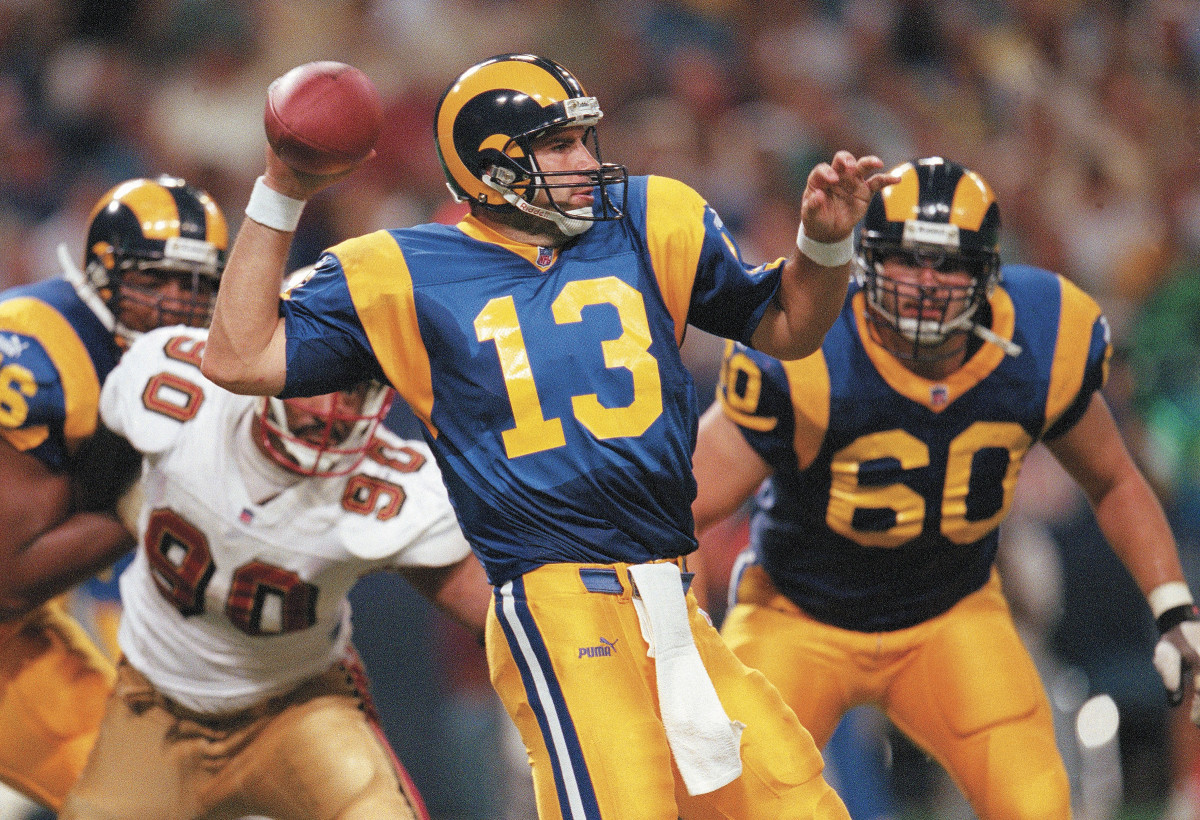
Why they mattered:
The 1999 Rams are remembered for Kurt Warner going from a grocery stocker to MVP. They’re also remembered for becoming the “Greatest Show on Turf.”
But most critical to their impact, the 1999 Rams redefined what it means to be a high-octane team in the modern age.
After having a losing record in every year of the 1990s, the Rams flourished under Dick Vermeil in his third season. With Warner installed as the starting quarterback after Trent Green’s torn ACL in the preseason. Warner was joined by veteran star receiver Isaac Bruce, rookie wideout Torry Holt and the newly acquired Marshall Faulk, with the running back coming over in a draft-day trade from the Colts.
The Rams showed the ability to hit on big first-down passing plays or when backed up in their own territory. They also married the deep ball with screens and other high-percentage throws to Faulk, stressing defenses at every level.
All told, they scored a league-best 526 points with first-year offensive coordinator Mike Martz utilizing the Air Coryell offense to perfection. Both Bruce and Faulk had 1,000-yard receiving seasons, while Warner became only the second player in NFL history to throw for 40-plus touchdowns in a single season.
Panel quote:
“[Trent] Green got hurt in the preseason, and nobody knew who Kurt Warner was at the time. They really didn’t change anything and went ahead. They had a vertical timing passing game that was based on speed cuts by the receivers, and they had great receivers. That was foundationally what their offense was. They also had a running back who was a dynamic weapon as a receiver as well as a runner, which allowed them to do a lot of different things. They also did something which a lot of teams had not done prior, which is play with four wide receivers.” —Greg Cosell, senior producer, NFL Films
Team quote:
“The combination of those five Hall of Fame–caliber players, along with talented players at the other positions who had invested two years into building what they were in the third year, they were an extremely hardworking group. … Never could we expect that team to be what it ended up being when the quarterback went down; Trent Green got hurt and here comes Kurt Warner. Nobody expected him to be what he ended up being. I thought he could play well, but I couldn’t tell you I thought he could be the MVP and the most valuable player in the Super Bowl. But his dynamic contribution just exploited all the talented athletes.” —Dick Vermeil, Rams coach, 1997–99
